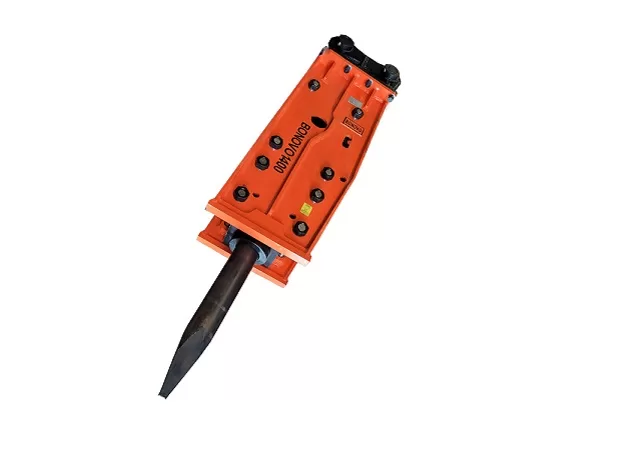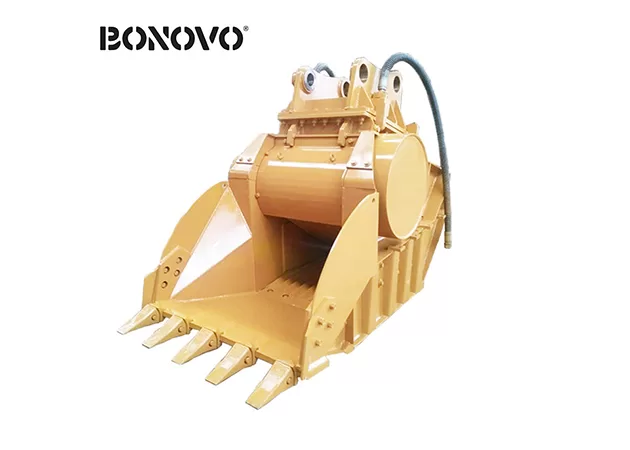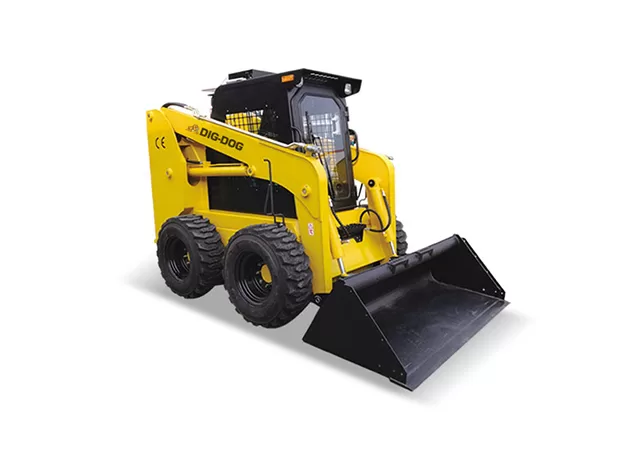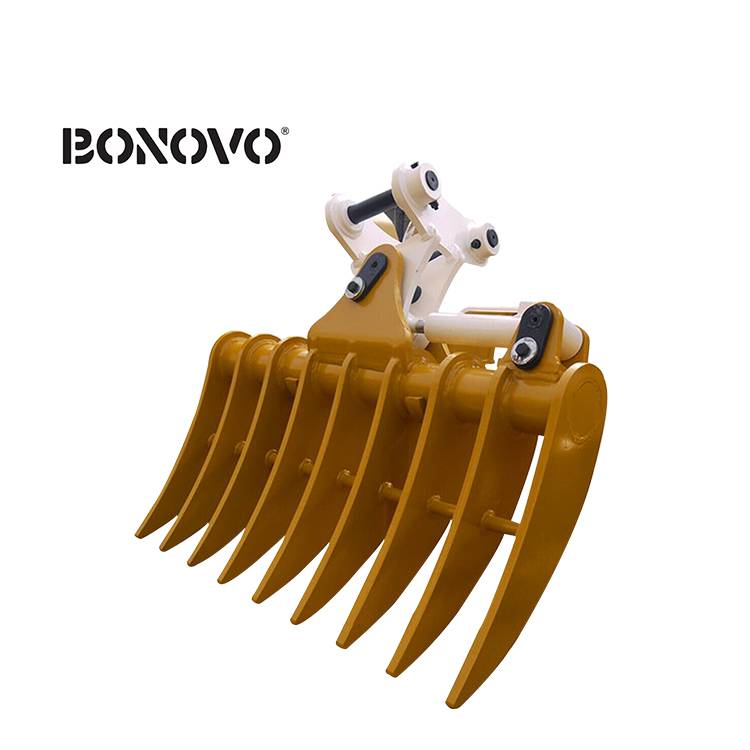How Does a Hydraulic Breaker Work? A Deep Dive into the Hammer's Working Principle - Bonovo
This article is for you every construction, demolition, and excavation professional who wants to look at their hydraulic hammer and understand not just that it works, but how it works. Understanding this working principle isn't just for curiosity's sake. It helps you make smarter purchasing decisions, troubleshoot problems more effectively, and perform maintenance that truly extends the life of your valuable attachment. Let's break it down together.
What Exactly is a Hydraulic Breaker and Why is it Essential?
A hydraulic breaker, often called a hydraulic hammer or simply a "breaker," is a powerful percussion hammer attachment fitted to an excavator or other construction machinery. Its sole purpose is to demolish tough materials. Think of it as a giant, super-powered chisel. Instead of a person swinging a sledgehammer, you have the immense hydraulic power of a base machine driving a hardened steel piston to deliver rapid, devastating blows. This makes it an indispensable tool for demolition, construction, and quarrying.
The use of hydraulic breakers has revolutionized job sites. Projects that would have taken days or weeks with manual demolition hammers or less efficient equipment can now be completed in a matter of hours. This dramatic increase in productivity is the primary reason why this attachment is a staple for so many businesses. Whether you're breaking up a concrete foundation, trenching through solid rock, or performing road surface excavation, the hydraulic breaker provides the raw power needed to get the job done efficiently and cost-effectively.
For companies looking to maximize the versatility of their hydraulic excavators, a breaker is a non-negotiable tool. It transforms a digging machine into a demolition powerhouse, expanding the range of services a company can offer. In my experience, a high-quality breaker pays for itself quickly through saved labor costs and accelerated project timelines.
How Does an Excavator Power the Hydraulic Hammer?
The magic of a hydraulic breaker begins with the excavator’s hydraulic system. Your excavator is essentially a mobile hydraulic power plant. It has a powerful engine that drives a hydraulic pump, which pressurizes hydraulic oil. This high-pressure oil is the lifeblood that powers every function of the machine, from moving the boom and arm to, in this case, operating an attachment like a breaker.
When you attach a hydraulic breaker to your excavator, you connect it via heavy-duty hydraulic hoses. These hoses deliver a continuous flow of pressurized hydraulic fluid from the excavator to the breaker. Inside the breaker, this flow is directed by a sophisticated control valve. This valve is the brain of the operation, channeling the hydraulic energy to drive the piston up and down.
It's a beautiful, direct transfer of energy. The excavator generates the power, and the hydraulic breaker converts it into mechanical force—specifically, the high-frequency, high-impact strikes of the piston. The efficiency of this process is why hydraulic breakers are so effective. The performance of the breaker is directly tied to the hydraulic flow and pressure supplied by the base machine, which is why it's crucial to match the breaker to the excavator's specifications.

What is the Core Working Principle of a Hydraulic Breaker?
Now we get to the heart of the matter. The working principle of a hydraulic breaker is a rapid, repeating cycle of energy conversion. It's a clever dance between hydraulic pressure and stored gas pressure. Let's walk through one complete cycle of the hammer work.
-
The Upstroke (Energy Storage): The cycle starts when the main valve directs the flow of high-pressure hydraulic oil to the bottom side of the piston. This hydraulic oil pressure pushes the piston upward, away from the tool (the chisel or moil point). As the piston moves upward, it travels into the upper part of the breaker, which contains a chamber of pressurized nitrogen gas. The upward movement of the piston head compresses the energy storage element, which is this nitrogen gas, building up immense potential energy, much like compressing a spring.
-
The Firing Position: As the piston reaches the top of its stroke, it uncovers a port that causes the internal valve to shift. This is the critical moment. The valve instantly changes the direction of the hydraulic oil flow. It cuts off the supply to the bottom of the piston and directs it back to the excavator's tank.
-
The Downstroke (Impact): With the hydraulic pressure underneath it gone, the highly compressed nitrogen gas in the upper chamber expands violently. This expansion slams the piston down with incredible speed and force. The piston strikes the top of the tool (chisel), transferring this massive kinetic energy through the tool and into the material you want to break, like concrete or rock. This single, powerful blow is the "percussion" in percussion hammer. This entire cycle happens many times per second, creating the signature hammering action of the breaker. This is the fundamental working principle behind its ability to demolish so effectively.
What is the Role of Nitrogen Gas in a Hydraulic Breaker?
Many people I talk to are surprised to learn about the critical role of nitrogen in a hydraulic breaker. They assume it's all hydraulics. But without nitrogen, the breaker would be nowhere near as powerful. The nitrogen gas, held in a sealed gas chamber (often called an accumulator), acts as a powerful energy storage device.
Think about it this way: hydraulic oil is not very compressible. You can use it to push things, but you can't easily "store" pressure in it like a spring. Gas, on the other hand, is highly compressible. The working principle of the hydraulic breaker leverages this property. The hydraulic system does the "heavy lifting" by pushing the piston up and compressing the nitrogen. The nitrogen gas then provides the explosive, rapid force for the downstroke.
This gas-fired system offers several advantages:
- Massive Impact Energy: It allows the breaker to generate much higher impact energy than a purely hydraulic system of the same size could.
- Reduced Shock: The accumulator also helps to absorb hydraulic pressure spikes, protecting the excavator's hydraulic system and the hydraulic hoses from damaging shocks.
- Efficiency: It creates a more efficient cycle, as the excavator only needs to provide pressure for the upstroke, not the impact stroke.
Maintaining the correct nitrogen charge is one of the most important aspects of hydraulic breaker maintenance. Too little pressure, and the hammer will have weak impacts. Too much, and it can damage the internal seal components.
What Are the Key Components Inside a Breaker and What Do They Do?
While it looks like a simple, solid piece of steel from the outside, a hydraulic breaker is a complex piece of precision engineering. Understanding its main parts helps in appreciating its working principle and in troubleshooting.
| Component | Function | Why It's Important |
|---|---|---|
| Cylinder Body | The main housing that contains all the internal working parts of the breaker. | Provides structural integrity and protects the delicate internal components from the harsh working conditions of a job site. |
| Piston | The core moving part. It's a heavy, hardened steel cylinder that moves up and down to strike the tool. | This is the "hammer" in hydraulic hammer. The mass and velocity of the piston determine the impact energy of the breaker. |
| Control Valve | Directs the flow of high-pressure hydraulic oil to either lift the piston or release the pressure for the downstroke. | It's the "brain" of the breaker. A malfunctioning valve is a common reason a breaker might stop working. |
| Tool (Chisel/Moil) | The interchangeable, hardened steel bit that makes direct contact with the material being demolished. | Different tool types (e.g., moil point, blunt tool, flat point tools) are used for different materials like concrete, rock, or asphalt. |
| Nitrogen Chamber | The sealed chamber at the top of the breaker containing pressurized nitrogen gas. | Acts as an energy accumulator, providing the power for the impact stroke of the piston. |
| Seals | A system of durable seals that prevent hydraulic oil from leaking and keep the nitrogen gas contained. | A failed seal can lead to a loss of power, contamination of the hydraulic system, and costly repairs. The durability of the seal is critical. |
As a manufacturer, we pay immense attention to the materials and precision of these components. The demand for high durability and low maintenance costs means using the highest quality wear-resistant steel for the piston and cylinder, and designing robust seal kits that can withstand extreme pressures and temperatures. The quality of these parts directly impacts the performance and lifespan of the entire hydraulic breaker.

Are There Different Types of Hydraulic Breakers?
Yes, while the core working principle is similar, hydraulic breakers come in different designs, primarily distinguished by their internal structure and how the valve and gas systems are configured. The two most common types you'll encounter are:
-
Internal Valve Type: In these breakers, the control valve mechanism is integrated directly into the cylinder body. They are often simpler in design, with fewer moving parts. This can make them more compact and sometimes easier to service. This design is very common in small to mid-size breakers, like a hydraulic breaker on your mini excavator.
-
External Valve Type: These breakers have a separate valve housing bolted onto the main cylinder. This design can sometimes offer higher performance in very large breakers, but it can also be more complex.
Another key distinction is the type of gas system, or accumulator:
- Diaphragm Type: A flexible rubber diaphragm separates the nitrogen from the hydraulic oil. They are very effective at dampening pressure spikes but can be susceptible to failure if the breaker is operated incorrectly (like "blank firing," or operating the breaker without it being pressed against a surface).
- Piston Type: A secondary piston separates the gas and oil. These are generally more robust and less prone to failure from improper use, making them a popular choice for rental fleets and demanding applications.
At BONOVO, we offer a range of hydraulic hammers to suit different needs, from smaller sizes for mini-excavators to massive units for large-scale demolition. The choice depends on the application, the base machine, and the operator's preference.
How Do You Select the Ideal Hydraulic Breaker for Your Machinery?
This is a critical question for any owner or fleet manager. Selecting the ideal hydraulic breaker is about more than just finding one that fits. It's a balance of several factors to ensure optimal performance, safety, and longevity for both the breaker and your excavator.
Here are the key things I advise my customers to consider:
- Carrier Weight: This is the number one rule. The size and weight of the hydraulic breaker must match the weight class of your excavator or loader. A breaker that is too heavy can make the excavator unstable and put excessive stress on the boom and arm. A breaker that is too light won't have the power to be effective and the excavator's powerful hydraulics could damage it.
- Hydraulic Flow Rate (GPM/LPM): Every hydraulic breaker has an optimal flow rate range. You must check your excavator's hydraulic output to ensure it falls within this range. Too little flow will result in a slow, weak hammer. Too much flow can cause the breaker to over-speed, generating excessive heat and causing premature failure of the seal kit and other components.
- Operating Pressure (PSI/Bar): Similar to flow rate, the breaker is designed to operate within a specific pressure range. The excavator's relief pressure must be set correctly to match the requirements of the breaker. Mismatched oil pressure is a primary cause of poor performance and damage.
- The Application: What will you be breaking? Breaking soft rock or thin concrete requires a different breaker than demolishing heavily reinforced concrete structures or tackling hard rock quarrying. Consider the type of work you do most often. You may need a breaker with higher impact energy for demolition versus one with higher frequency for scaling or trenching. A versatile tool like a BONOVO Crusher Bucket can also be a great complement for processing demolished material on-site.
Getting this match right is the first step to a successful and profitable experience with your hydraulic hammer.

What Causes a Hydraulic Breaker to Stop Working?
A hydraulic breaker that suddenly stops working can bring a job to a halt. Based on the calls I get from the field, the problem usually falls into one of a few categories. Understanding the working principle makes troubleshooting much easier.
- Hydraulic Supply Issues: This is the most common culprit.
- Incorrect flow/pressure from the excavator.
- Hose problems: Are the quick-couplers fully engaged? Is there a kink or blockage in a hydraulic hose?
- Low hydraulic oil in the excavator.
- Nitrogen Charge is Incorrect: If the nitrogen gas has leaked out, the piston has no "spring" to power its downstroke. The breaker might cycle up and down slowly but will have no impact force. This is why regular pressure checks are vital.
- Internal Component Failure:
- Failed Seals: A blown seal will cause a loss of either hydraulic or gas pressure. You might see hydraulic oil leaking from the breaker.
- Stuck or Broken Piston: This is a serious mechanical failure, often caused by poor lubrication or operating the breaker at an improper angle for extended periods.
- Valve Malfunction: The control valve might be stuck or damaged, preventing it from directing the hydraulic oil correctly.
- Operator Error:
- Blank Firing: Operating the breaker when the tool is not pressed firmly against a work surface. This sends violent shockwaves through the breaker itself, as there's no material to absorb the energy. It's a leading cause of tie-rod and piston failure.
- Using the Breaker as a Pry Bar: The breaker is designed for percussion, not for prying. This puts immense side-load on the piston, bushings, and tool, leading to rapid wear and catastrophic failure.
Often, what seems like a broken breaker is actually an issue with the hydraulic supply from the base machine, like a Skid Steer Loader WSL100. Always check the simple things first before assuming a major internal failure.
How Can You Maintain Your Hydraulic Hammer for Peak Performance?
Proper maintenance is the single best way to ensure your hydraulic breaker provides a long, profitable service life. It’s all about preventing problems before they start. The goal is high durability and low maintenance costs.
Here's a simple but effective maintenance checklist:
- Daily Greasing: The area where the tool (chisel) slides inside the breaker is a high-friction zone. It must be greased every couple of hours of operation. Use a high-quality grease specifically designed for high-temperature, high-pressure applications. This simple step helps prevent premature wear on the tool and front bushings.
- Regularly Check the Nitrogen Charge: As we've discussed, the nitrogen pressure is critical to the breaker's working principle. Check the pressure according to the manufacturer's schedule (e.g., weekly or every 50 hours). A proper charging kit is an essential piece of support equipment.
- Inspect Hoses and Fittings: Before each use, give the hydraulic hoses and fittings a quick visual inspection. Look for leaks, cracks, or abrasions. A failed hose not only stops the job but can also be a major safety hazard.
- Listen to Your Breaker: An experienced operator can tell a lot by the sound of their hammer. If it starts to sound different—weaker, or making an odd metallic noise—stop and investigate. It could be the first sign of a problem.
- Follow the Service Interval: Your breaker manual will specify service intervals for things like changing the seal kits. Adhering to this schedule, even if the breaker seems to be working fine, is much cheaper than dealing with a major failure down the road. Quality replacement parts, like durable Bushings for Excavator & Loader, are key to a successful rebuild.

What Are the Safety Considerations for Hydraulic Breaker Operation?
A hydraulic breaker is an incredibly powerful tool, and with that power comes a responsibility to operate it safely. Hydraulic breaker operation requires awareness and adherence to strict safety protocols.
- Flying Debris: Breaking concrete and rock sends sharp fragments flying at high velocity. The excavator cab must have proper guarding (like a polycarbonate shield), and no one should be in the vicinity of the breaker while it's operating.
- Hydraulic Safety: High-pressure hydraulic oil is extremely dangerous. A pinhole leak can inject fluid into the skin, causing severe injury. Never check for leaks with your hand; use a piece of cardboard or wood. Always relieve the system pressure before disconnecting hoses.
- Correct Operating Procedure: As mentioned, avoid blank firing and using the breaker to pry. Always position the breaker perpendicular (at a 90-degree angle) to the work surface for maximum efficiency when breaking and to minimize side-loading stress on the components.
- Secure Attachment: Before starting, always ensure the breaker is securely attached to the excavator, whether through a direct pin-on connection or a quick coupler.
Safety is paramount. In the design of our attachments, we incorporate features that align with global safety standards, but the ultimate responsibility for safe operation always lies with a well-trained and vigilant operator.
Key Takeaways
I hope this detailed look into the working principle of a hydraulic breaker has been helpful. It’s a fascinating piece of engineering that turns the steady power of your excavator into a formidable demolition force.
Here are the most important things to remember:
- It's a Team Effort: The hydraulic breaker relies on a partnership between the excavator's hydraulic system (providing pressure for the upstroke) and a chamber of nitrogen gas (providing the explosive energy for the downstroke).
- The Valve is the Brain: A control valve directs this cycle, shifting the flow of hydraulic oil to make the piston reciprocate rapidly.
- Matching is Key: The performance and lifespan of your breaker depend on correctly matching its size, weight, flow, and pressure requirements to your excavator.
- Maintenance is Not Optional: Regular greasing and checking the nitrogen charge are the two most critical maintenance tasks you can perform to prevent downtime and expensive repairs.
- Operate with Respect: Understanding how a breaker works also means understanding its limitations. Always use the correct operating techniques to ensure safety and protect your investment.




